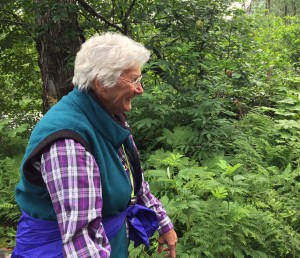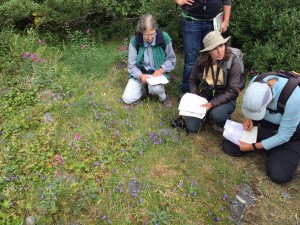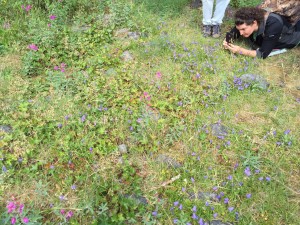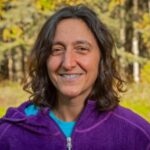
Eighty years ago Verna Pratt was more comfortable with the violets and buttercups of rural Massachusetts than with people. But her early affection for flowers led her on an unexpected path to notoriety more than 3,000 miles away. She recently led an Alaska Geographic class on wildflowers of the Chugach.
Clad in four shades of purple, Verna Pratt stands next to a patch of tangled grasses and plants, pointing at the only tiny spots of color. Her shock of white hair, wide round glasses, and deep smile lines are the only indicators of her 84 years. A group of women surround her, pencils poised to jot down the Latin names and descriptions of plants.
“The scientific name is campanula rotundifolia. And it gets that name from this little basal leaf,” she says, pointing to the base of the plant. “And I don’t call that round.” She chuckles loudly.
Pratt’s laughter punctuates the end of most of her sentences, sometimes seeming to say “Silly botanists! Why name it that?” The class of 11 women pull out their tiny magnifying lenses to inspect the details of a Sitka Burnet.
“Well, it’s just so cool!” exclaims Gretchen Hazen, a self-described “Verna Groupie.” “Ooh, it smells lovely! You have to get your nose close.”
Hazen has taken four different classes with Pratt and has been tracking flower sightings in her copy of Pratt’s “Field Guide to Alaskan Wildflowers” for almost two decades. Pratt’s self-published book will soon be on it’s 16th printing and has sold more than 100,000 copies.
Walking past Byron Creek, Pratt is still processing the palpable group adoration. She sighs and pauses. “Actually, it’s gratifying. At first it’s almost embarrassing, but then eventually it’s gratifying because you can see that they’re enjoying themselves. And they feel good about the fact that they can identify something.”
When she was younger, Pratt never foresaw this as her future. “I was practically almost a dropout in elementary school. I didn’t even try, until I got to high school. I finally woke up.”
But even then, she wasn’t known as outgoing at the tiny school she attended from kindergarten until graduation. “I’m a little farm girl. I was so shy and backwoodsy, it was terrible.”

When she was a sophomore, a new boy joined the class, Frank Pratt, and five years later they married. When he joined the military, she left her rural Massachusetts home with its fields of vegetables and a roadside produce stand for Detroit and then New Orleans. Every place they went, she took her children to parks and sought out the green spaces.
“That’s what kept me going, was learning the plants, wherever I went. Once I got through that first move. I think that first move was tough, but after that I just went out searching for new plants. It became an obsession.”
When they moved to Alaska in 1966, plants began taking over her life. Pratt says the flowers were so different from home she was quickly entranced. Her husband soon realized that he couldn’t compete with the flowers for her time, so he’d better start taking photos of them. Eventually she started teaching classes, but it was difficult because there weren’t any easy-to-use identification guides.
“I was listening to people’s gripes. That’s how I decided how to organize the book. You know they kept saying, ‘Organize it so we can recognize things without having to go through a lot of education and study to get there.'”
So her husband helped her use their son’s computer to compile the color-coded flower guide then used money from a small inheritance and a second loan on their house to self-publish the book in 1989. They disagreed over how many copies to print.
“I said 10,000, my husband just about fainted. He said, ‘5,000!’ I said, ‘No, gotta be more than that.’ We printed 7,500 and had to reprint in a month. And I’m like, ‘Oh geez!'”

They went on to write three other guides and a children’s book. Pratt has spoken about plants in the U.S. and abroad and is considered by many enthusiasts to be an expert. But with only a high school education, Pratt says she’ll never officially hold that title. She can’t rename plants to more accurately reflect their genus or get any credit for identifying a new species.
“I mean, is that frustrating to you?” I ask.
“No, no,” she quickly interrupts. “I know where I belong.”
“And where is that?”
“Just above you guys.”
But at that, her groupies just laugh. To them, Pratt’s on a level she probably can’t imagine.
Anne Hillman is the healthy communities editor at Alaska Public Media and a host of Hometown, Alaska. Reach her at ahillman@alaskapublic.org. Read more about Anne here.





